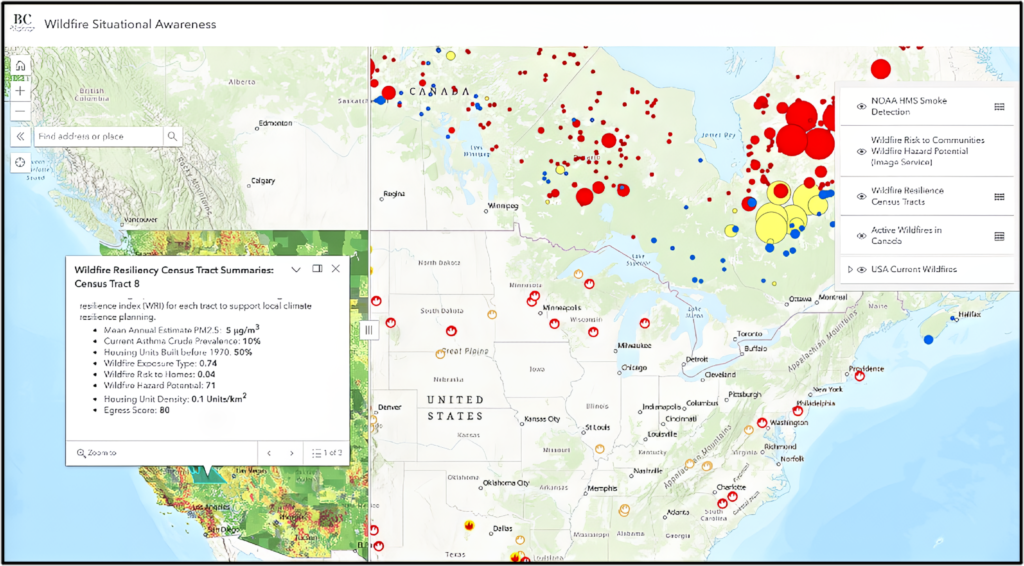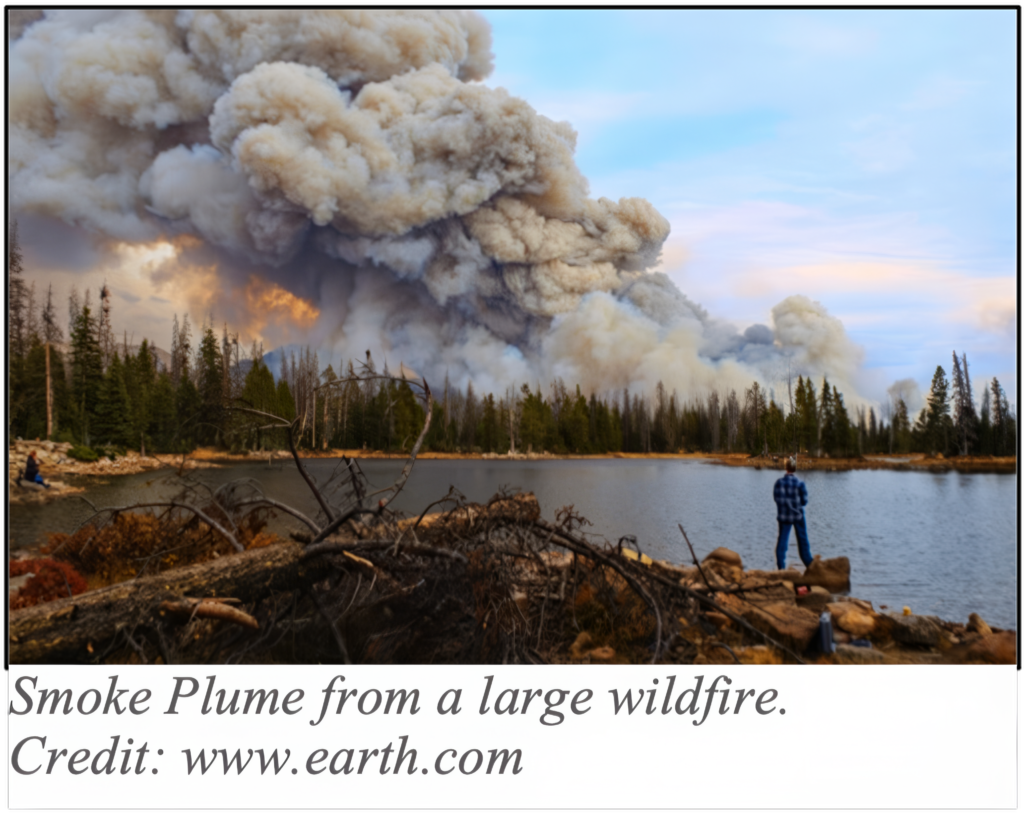 Wildfire smoke has had a definite impact on communities worldwide in the past five years. The severity of wildfires exposes individuals to hazardous levels of smoke, which may lead to significant health concerns and disruptions in daily life. It is crucial to acknowledge that the impacts of wildfire smoke are multifaceted and can have far-reaching consequences for communities. Additionally, there is significant potential impact for performing arts organizations. On June 28, it was reported that an outdoor concert was cancelled at Breece Stevens Field in Madison, Wisconsin. (Shepherd, 2023)
Wildfire smoke has had a definite impact on communities worldwide in the past five years. The severity of wildfires exposes individuals to hazardous levels of smoke, which may lead to significant health concerns and disruptions in daily life. It is crucial to acknowledge that the impacts of wildfire smoke are multifaceted and can have far-reaching consequences for communities. Additionally, there is significant potential impact for performing arts organizations. On June 28, it was reported that an outdoor concert was cancelled at Breece Stevens Field in Madison, Wisconsin. (Shepherd, 2023)
Another news article on the same day reported that a major concert in Ohio was cancelled because of smoke. The report cited a Live Nation statement, “Due to the unforeseen and unfortunate impact of the Canadian forest fires on the air quality in the Akron and Summit County area, tonight’s sold-out concert with Robert Plant & Alison Krauss at Blossom Music Center has been canceled. Live Nation, management, and artists made this coordinated decision in the interest of public safety, and in light of the Summit County Public Health statement, for audiences, crews, artists and all concerned.” (Abram, 2023)
Efforts to mitigate these effects require collaboration among government agencies, public health organizations, emergency responders, community members, and local organizations. By gaining understanding and implementing preventative measures, the performing arts community can work towards minimizing the adverse effects of wildfire smoke and enhancing their resiliency in the face of future wildfires.
Although there is little that can be done to stop smoke encroachment, performing arts organizations can arm themselves with information can help minimize the effects. To understand the impact of nuisance smoke encroaching on communities, it is helpful to build contextual reference to recognize just how much of a problem it has been. Where there’s smoke, there’s fire! A look into the number of fires in recent history can help understand the potential for the type of smoke that drifts over long distances.
Wildfire Frequency and Severity
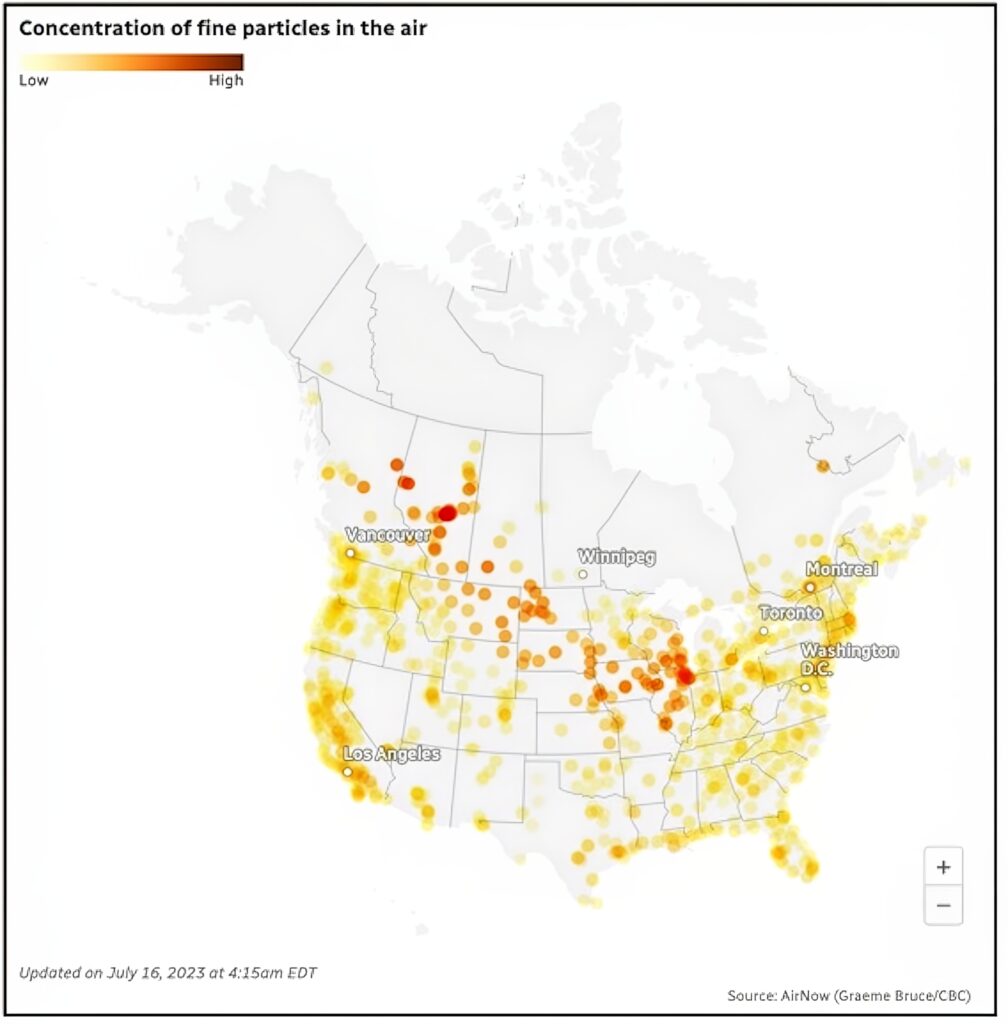 Canadian Wildfire statistics for July 19, 2023 showed that 5 of 39 territories were ranked moderate or high risk on the Air Quality Health Index. Officials also acknowledge of the severity of smoke drift over the United States (Figure 1). (News, Canada's wildfires: Where they are, how much has burned and how it's changing air quality, 2023)
Canadian Wildfire statistics for July 19, 2023 showed that 5 of 39 territories were ranked moderate or high risk on the Air Quality Health Index. Officials also acknowledge of the severity of smoke drift over the United States (Figure 1). (News, Canada's wildfires: Where they are, how much has burned and how it's changing air quality, 2023)
This year is the most active in recent times. According to a June 10th Canadian Broadcasting Corporation report, “Four million hectares already burned by June 6, surpassing the annual totals for every year going back to 2016. A government forecast suggests this will continue to be a severe year.” (News, Federal data forecasts grim wildfire season this summer, 2023)
The same report states that so far this season, 2,214 fires are responsible for more than three million hectares burned in Canada. The ten-year average over the same period was 1,624 fires and 254,429 hectares. Although nearly half of these were started from lightning, “Mike Norton, director general of the Northern Forestry Centre at the Department of Natural Resources, told reporters Monday morning (June 5) that seeing so many fires across the country at this time of year is not normal.” (News, Federal data forecasts grim wildfire season this summer, 2023)
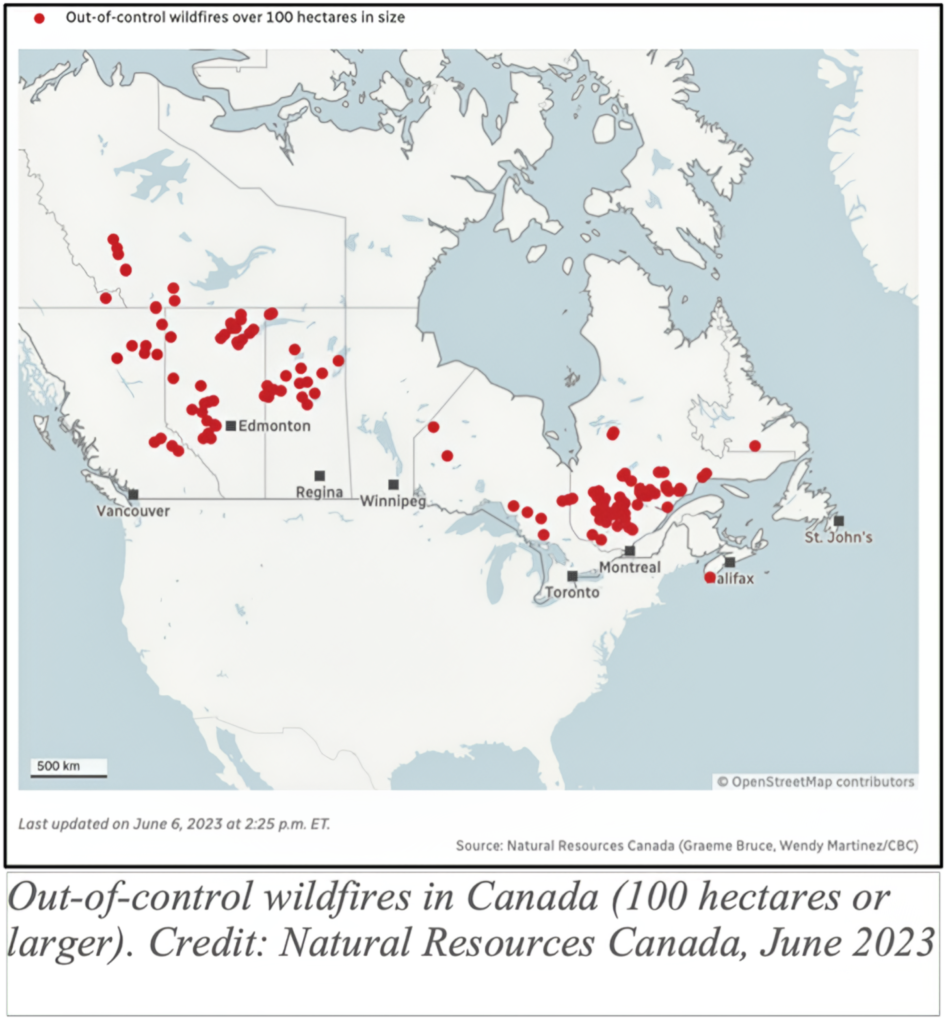
In the United States, the National Interagency Fire Center (NIFC) is an authoritative source for wildfire information. The 2022 annual report says, “There were 1,289 large wildfires and complexes reported in 2022 through the SIT/209 application. Large wildfires represented less than 2% of total wildfires reported nationally in 2022.” (Center, 2022) Large wildfires are defined as being at least 100 acres in heavily wooded areas, or 300 acres in open grassy areas.
 Further review of the NIFC data gives more of a historical perspective. In 2022, there were nearly 70,000 wildfires in the United States which were responsible for 7.5 million acres (about the area of Massachusetts) burned. This is very closely aligned to the 10-year averages for each data point. There were just over 61,000 wildfires, and 7.4 million acres burned on a 10-year average (Figures 2 & 3). (Center, 2022)
Further review of the NIFC data gives more of a historical perspective. In 2022, there were nearly 70,000 wildfires in the United States which were responsible for 7.5 million acres (about the area of Massachusetts) burned. This is very closely aligned to the 10-year averages for each data point. There were just over 61,000 wildfires, and 7.4 million acres burned on a 10-year average (Figures 2 & 3). (Center, 2022)
Another useful data point is the number of times the National Preparedness Level was elevated to the highest state of readiness. Preparedness Levels are determined and implemented by consideration of fuel and weather conditions, fire activity, and fire suppression resource availability throughout the country. The five Preparedness Levels range from the lowest (1) to the highest (5). In 2022, the highest state of readiness was declared 10 times. Considering historical data, the National Interagency Fire Center concludes that Preparedness Levels 4 and 5 were declared an average of 43 times over a 10-year period (Figure 3). (Center, 2022)
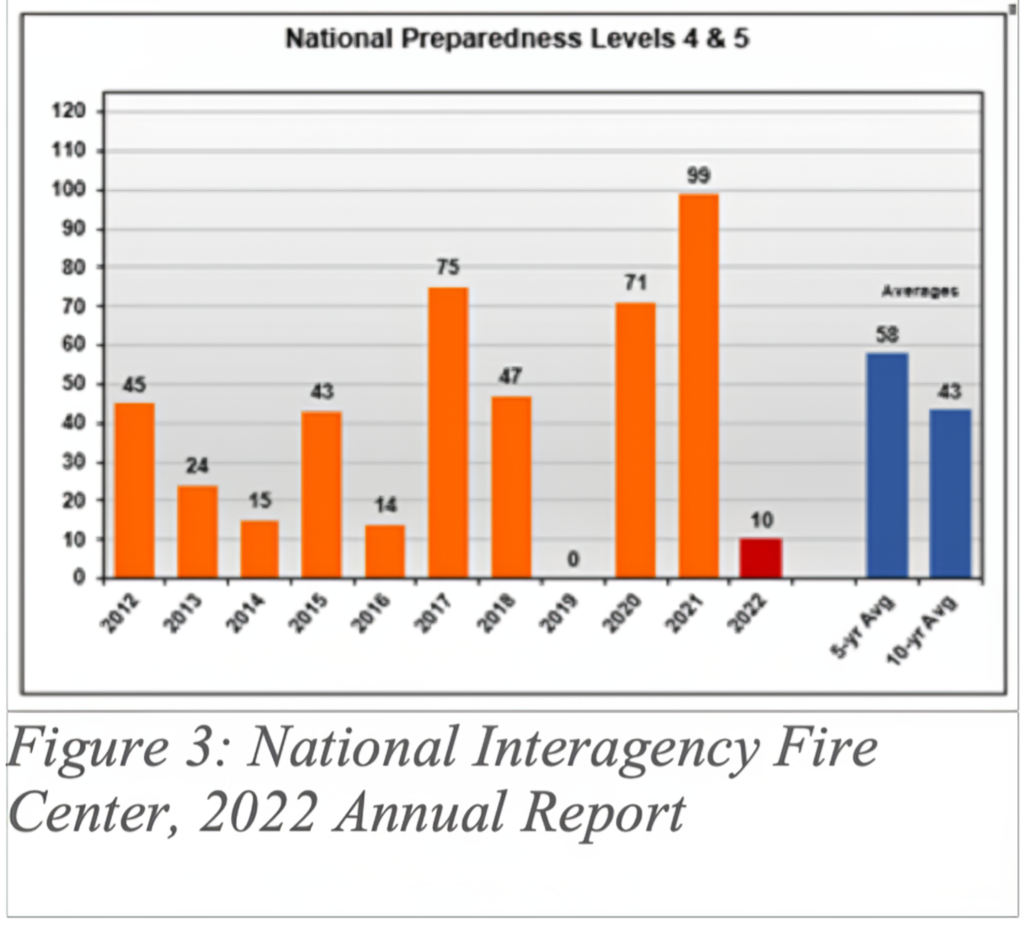
As of July 19, 2023, the U.S. fire activity for the year so far is reported by the National Interagency Fire Center (Center, 2022):
- 25 large fires active
- 138,919 acres burned on large fires
- 27,715 wildfires year-to-date
- 793,198 acres burned year-to-date
Impact of Smoke
Whether one of these fires is directly impacting a community or the smoke encroaches from a great distance, there are very good reasons to be concerned. It is essential to understand the various impacts that smoke may have on individuals, communities, and businesses.
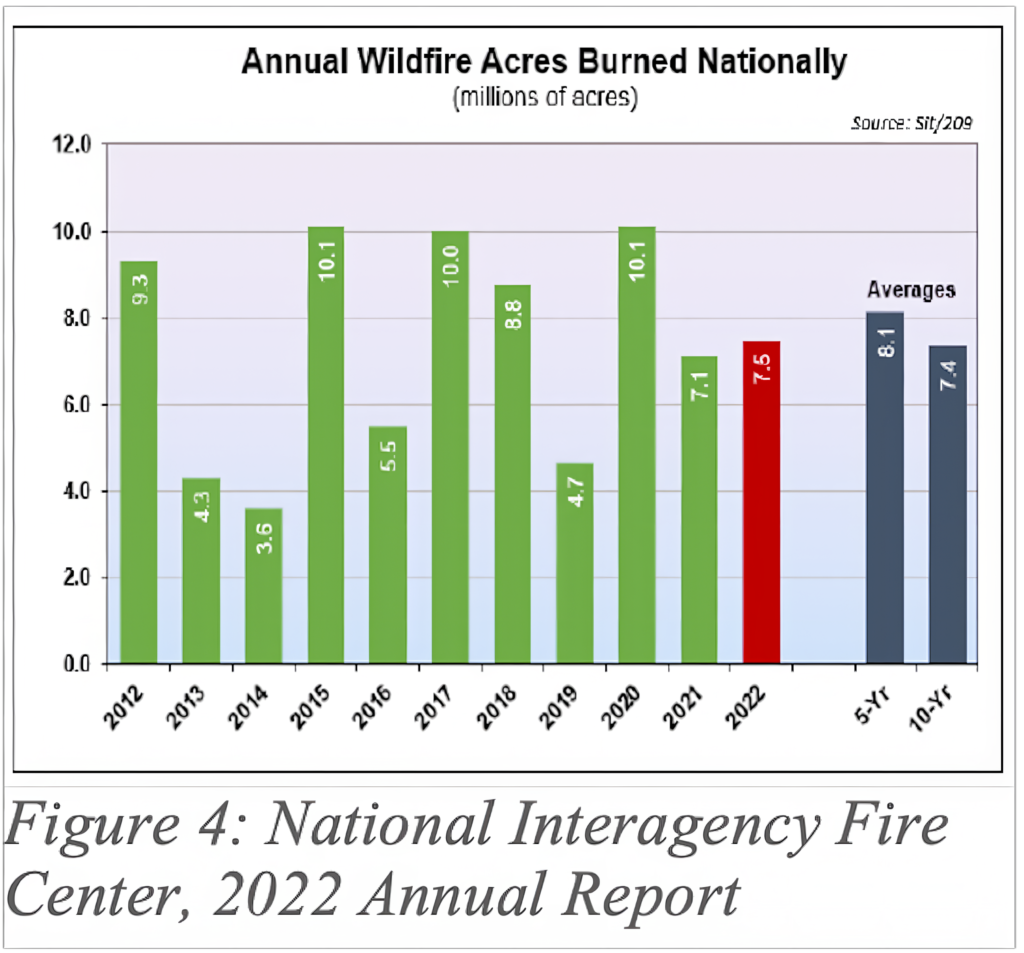
Concerns stem from wildfire smoke significantly degrading air quality, resulting in poor visibility and elevated levels of pollutants. The Environmental Protection Agency (EPA) and local monitoring stations continually evaluate levels of fine particulate matter (PM2.5), ozone, and carbon monoxide during wildfire events. In some cases, the smoke has traveled hundreds of miles, which can have adverse effects on the environment.
In addition to the degraded quality of the air, wildfire smoke contains a complex mixture of particles and gases that can have adverse effects on human health. Prolonged exposure to smoke, particularly fine particulate matter, can lead to respiratory issues. “Some particles less than 10 micrometers in diameter can get deep into your lungs and some may even get into your bloodstream. Of these, particles less than 2.5 micrometers in diameter, also known as fine particles or PM2.5, pose the greatest risk to health.” (Particulate Matter Basics, 2023) It is important for individuals to understand how smoke exposure will affect them personally and seek medical attention promptly if necessary.
More than smoke hazards, some communities will be impacted by the immediate need for evacuation. As wildfires approach, evacuation orders become necessary to protect residents from imminent danger. Of course, this disrupts daily life, causing displacement and uncertainty for affected individuals and communities. Performing arts organizations should ensure evacuation and communication plans are practiced regularly in case they are needed.
For communities currently experiencing wildfires, the cumulative stress related to prolonged smoke exposure, evacuations, and overall uncertainty takes a toll on mental health and well-being. Disruptions to daily routines, fear of recurring events, and loss of homes or natural landscapes can also contribute to emotional distress.
For communities experiencing smoke encroachment, economic consequences associated with smoke are worth consideration. Certainly, it has been recently shown that outdoor events are immediately susceptible to risk of smoke causing financial hardship for everyone involved. Further economic impact to communities can include damage to infrastructure, loss of crops and livestock, increased healthcare costs, and less tourism.
Significantly, the performing arts industry is entwined in the 2nd largest economic sector in the country. “The U.S. Bureau of Economic Analysis reports that arts and cultural production accounts for $1,016,249,142,000 and 4.4% of the U.S. economy, contributing 4,851,046 jobs.” (National Assembly of State Arts Agencies, 2020) Although the smoke will dissipate over time, these effects can have long-term implications for local economies and may require substantial resources for recovery and rebuilding. The importance to the performing arts community cannot be understated.
Situational Awareness
As performing arts organizations make plans for special events, look to protect patrons, or monitor local hazards it is important to engage in risk assessment activities as a first step. One of the most useful resources in this effort is the local emergency management office (EMO). The role of an EMO is to absorb and distribute information from a myriad of sources to the community it serves. Additionally, the EMO can be an invaluable partner to organizations in risk assessment, response and recovery operations, and mitigation planning.
Viewing the problem along a timeline may help understand and react to situations affecting the community. Initially, as a wildfire increases in size so does the amount of smoke. As the smoke builds, weather conditions influence where it drifts and in what concentration. Monitoring and evaluating this behavior helps determine mitigation strategies to improve the resilience of the people and the things we care about.
As mentioned, monitoring the weather should be a first step in evaluating how smoke might impact the area. It is a primary consideration in every aspect of a wildfire; a key consideration in controlling and extinguishing a fire and dictates how smoke will move throughout the atmosphere. Certain weather conditions direct the smoke directly upwards, pushing a smoke plume high in the air. Other conditions hold the smoke to a lower elevation where it can be carried in several ways by wind currents. If enough smoke is generated by one, or multiple fires, the air becomes saturated with smoke particles. It becomes more difficult for the wind to disperse the smoke into the atmosphere when this occurs. Instead, the particles may stick together and migrate over long distances.
When wildfire smoke blankets an area it often interacts with weather patterns, particularly through an atmospheric phenomenon called inversion. This occurs when a layer of warm air traps cooler air beneath it, inhibiting vertical mixing. This inversion layer can trap smoke near the ground, resulting in poor air quality. A more familiar representation of this effect is fog. Warmer air holds cooler air, and humidity, close to the ground resulting in those difficult driving conditions. Of course, the inversion holding smoke to lower levels is worrisome for its impact on our everyday lives.
As a picture is formed for how the smoke is behaving, an organization can evaluate how much of a health concern is associated with expected conditions. Organizations such as OSHA have established permissible exposure limits (PEL) to safeguard public health and safety. These limits define the maximum allowable concentrations of specific contaminants in the air over a given time period. When it comes to wildfire smoke, the primary concern is PM2.5. While specific PELs may vary depending on the region, it is crucial to consult with your local EMO for precise guidelines applicable to your area.
To stay informed about smoke-related risks, it is useful to not only monitor news and social media, but also be plugged into the community notification system. In general, however, there are many tools available that help to stay informed on situations like smoke encroachment. Situational awareness platforms, based in geographic information system (GIS), that offer real-time updates to make informed decisions are one of the best solutions for establishing an internal capability.
Although there are many such tools to choose from, this Wildfire Situational Awareness Tool (Figure 5) is offered as a demonstration, and to encourage the use current information in your resilience actions. This tool curates many sources of information into a single picture to provide current information and in-depth analysis. With it, the user is able to see current fire locations overlayed with smoke dispersion and severity patterns as defined by the National Oceanic and Atmospheric Administration (NOAA). Additionally, risk and resilience analysis is provided from authoritative sources such as the US Census Bureau, US Centers for Disease Control and Prevention, US Forest Service, and ESRI. It will remain available for the foreseeable future, at no charge, as a service to your efforts in protecting cultural heritage (and its caretakers).
Precautionary Measures
Armed with information on how frequently large fires occur, what the impacts of smoke encroachment may be, how the smoke travels, and how to monitor your current situation, we can finally turn to precautions. These are a few things you can do for yourself and for your organization.
Precautions for individuals when there is smoke encroachment:
- Stay Informed: Regularly check local air quality reports, weather forecasts, and updates from authorities. Register with the local notification system managed by the emergency management office.
- Minimize Exposure: Limit outdoor activities, especially during periods of poor air quality. Keep windows and doors closed to prevent smoke from entering your home. Use air purifiers or create a clean indoor environment by sealing any gaps or cracks.
- Use Personal Protective Equipment (PPE): If you must go outside, consider wearing N95 or P100 respirators, which are designed to filter out fine particles. Follow proper fitting instructions and replace masks as recommended.
- Create a Clean Space: Designate a specific room in your home as a clean space with effective air filtration. This can provide relief from smoke exposure, particularly for vulnerable individuals.
Precautions for Organizations:
- Performing arts organizations, and business in general, should focus on workplace safety standards and conduct air quality assessments to determine exposure risks to employees.
- Develop an Emergency Response Plan: Create a comprehensive plan that outlines procedures to follow during wildfire events, including smoke-related precautions. Assign responsibilities, establish communication channels, and ensure employees are trained on the plan.
- Assess Indoor Air Quality: Conduct air quality assessments to determine the presence and levels of contaminants, including fine particulate matter. This evaluation will help identify areas that require specific attention or mitigation measures.
- Provide PPE and Training: Supply appropriate personal protective equipment, such as N95 masks, to employees who may be exposed to wildfire smoke. Conduct training sessions on proper usage, maintenance, and disposal of PPE.
- Modify Work Schedules or Locations: Consider implementing flexible work schedules or remote work options during periods of poor air quality. If feasible, provide designated clean areas within the workspace where employees can seek refuge from smoke.
- Communicate with Employees and Patrons: Keep employees and customers informed about air quality conditions, precautions being taken, performance delays, cancellations, or cautions during smoke encroachment. Utilize various communication channels to ensure the information reaches all stakeholders.
- Evacuation Plan Considerations:
- Identify critical documents, data, and essential items for business continuity
- Designate specific roles & responsibilities to employees
- Identify 2 escape routes (primary & alternate) and a meeting place far away from the problem causing evacuations
- Develop plans to communicate with employees and patrons
- Practice the plan!
- More recommendations are available from the California Department of Industrial Relations, Protecting Outdoor Workers Exposed to Smoke from Wildfires, https://www.dir.ca.gov/dosh/wildfire/worker-protection-from-wildfire-smoke.html
- Additional wildfire preparedness information is available with a previous Performing Arts Case Study: Wildfire Preparedness, https://performingartsreadiness.org/wildfire-preparedness-defensible-space/
Conclusion:
When smoke from wildfires encroaches on your city, understanding the historic context, the impact of smoke encroachment, and how smoke persists are important to safeguarding the people and things we care about. By prioritizing preparedness and situational awareness, performing arts organizations can design appropriate measures to minimize health risks. Specific plans, air quality assessments, PPE, and effective communications with employees and customers should be included in an organization’s larger emergency response plan. By maintaining situational awareness, acting proactively, and relying on reputable sources such as the local emergency management office, it is possible to navigate the challenges posed by wildfire smoke and prioritize safety.
* * *
Chris Soliz (csoliz@bridgewayconsultingllc.com) is a Fire Safety & Disaster Preparedness Consultant with Bridgeway Consulting. He has been a firefighter and emergency management professional for 29 years and works with non-profits for fire safety and preparedness. He has worked with government, private, and non-profit organizations to develop plans, command large-scale emergencies, manage special events, and coordinate resource management. Chris holds a master’s degree in emergency services management and is credentialed as an Incident Commander for North Carolina’s Incident Management Team. To focus this knowledge on cultural heritage protection, he has completed specialized studies by Leiden University, and the Institute of Disaster Mitigation for Urban Cultural Heritage, at Ritsumeikan University in Kyoto, Japan.
Works Cited
Abram, M. X. (2023, June 28). Cleveland.com. Retrieved from https://www.cleveland.com/entertainment/2023/06/robert-plant-and-alison-krauss-concert-canceled-due-to-canadian-wildfires.html
Center, N. I. (2022). Wildland Fire Summary and Statistics Annual Report. Retrieved July 2023, from National Interagency Fire Center: https://www.nifc.gov/fire-information/statistics
National Assembly of State Arts Agencies. (2020). Retrieved from Creative Economy State Profiles: https://nasaa-arts.org/nasaa_research/creative-economy-state-profiles/
News, C. (2023, June 10). Canada's wildfires: Where they are, how much has burned and how it's changing air quality.Retrieved from CBC News: https://www.cbc.ca/news/canada/canada-fires-map-air-quality-1.6871563
News, C. (2023, June 6). Federal data forecasts grim wildfire season this summer. Retrieved from https://www.cbc.ca/news/politics/wildfires-outlook-forecast-1.6865791
Particulate Matter Basics. (2023, July 11). Retrieved from Environmental Protection Agency: https://www.epa.gov/pm-pollution/particulate-matter-pm-basics
Shepherd, M. (2023, June 28). Canadian Wildfire Smoke Cancels A Major Concert In Wisconsin—It’s The Right Call.Retrieved from Forbes: https://www.forbes.com/sites/marshallshepherd/2023/06/28/canadian-wildfire-smoke-cancels-a-major-concert-in-wisconsinits-the-right-call/?sh=3a2c39152e90

